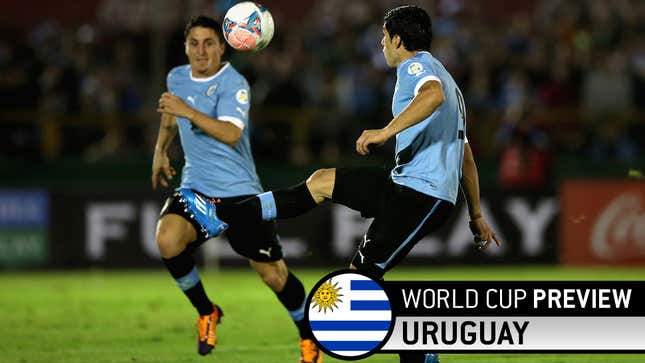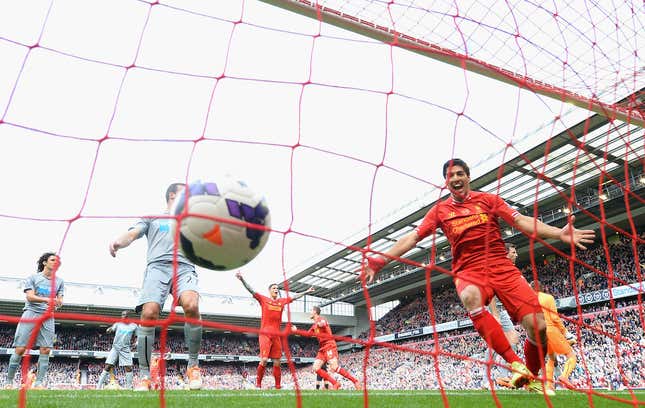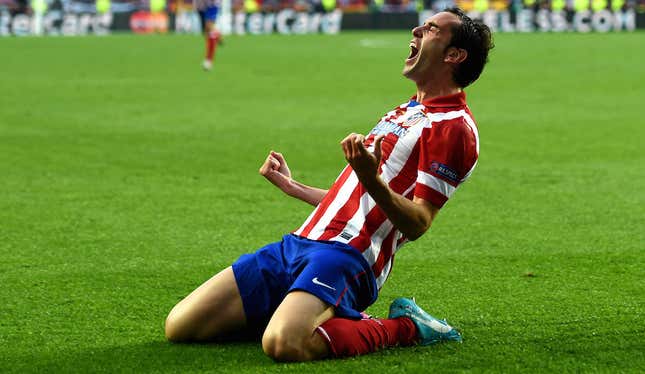
Many believed that Uruguay's dramatic run to the World Cup semifinals in 2010 was somewhat of a surprise. It wasn't.
They were, and are, absolutely stacked. La Celeste erased any doubt that they were a flash in the pan by winning the 2011 Copa América, South America's quadrennial cup tournament. Uruguay struggled a bit in the group stage, before knocking out host Argentina in the quarterfinals. From there, it was a 2-0 drubbing of Peru and a 3-0 demolition of Paraguay that saw the Uruguayans lift their 15th Copa América trophy. The phenomenal performance in South Africa and the victory in Argentina led many to expect Uruguay to be one of the top contenders in Brazil.
But they almost didn't get there. After struggling for much of the qualifying campaign, including a 4-0 defeat to Colombia, a 3-0 loss to Argentina, and worst of all a 4-1 defeat to Bolivia, Uruguay finished in 5th, forcing them to play a two-legged playoff in order to secure their place in Brazil. Fortunately, their opponent was Jordan. A 5-0 away win for La Celeste in the opening leg ended the Jordanian's hopes, and Uruguay found itself not only in the World Cup field, but, thanks to their World Cup and Copa América success, as one of eight seeded teams.
Also working in Uruguay's favor? The last time the World Cup was held in Brazil, in 1950, the Uruguayans upset the heavily-favored hosts in the final.
Roster
Goalies: Fernando Muslera (Galatasaray), Martín Silva (Vasco da Gama), Rodrigo Muñoz (Libertad)
Defenders:Maximiliano Pereira (Benfica), Diego Lugano (West Brom), Diego Godín (Atlético Madrid), Jose Maria Giménez (Atlético Madrid), Sebastián Coates (Liverpool), Martín Cáceres (Juventus), Jorge Fucile (Porto)
Midfielders: Álvaro González (Lazio), Álvaro Pereira (Sao Paulo), Walter Gargano (Parma), Egidio Arévalo Rios (Morelia), Diego Pérez (Bologna), Cristian Rodríguez (Atlético Madrid), Gastón Ramírez (Southampton), Nicolás Lodeiro (Botafogo)
Forwards: Luis Suárez (Liverpool), Edinson Cavani (Paris St Germain), Abel Hernández (Palermo), Diego Forlán (Cerezo Osaka), Christian Stuani (Espanyol)
Nickname
La Celeste
FIFA World Ranking
7
Manager
Óscar Tabárez
Players to Watch
Luis Suárez, Forward

You may have heard of Luis Suárez before. Maybe it's from 2010, when he bit an opposing defender in the Dutch League. Or it could be from 2011, when he allegedly used racist language against Manchester United's Patrice Evra. Or perhaps it's from 2013, when he again bit an opposing defender, this time Chelsea's Branislav Ivanovic. There's little doubt that Suárez frequently crosses the line with his aggressive play, and also little doubt that gravity appears to affect him far more powerfully than any other human on earth.
But for all his "issues" on the field, Suárez is, undeniably, one of the greatest strikers in the world. He's not particular tall, or strong, or fast, but he's quite possibly the most exciting single player in the sport.
And that's because, above all, Suárez is a demon on the pitch. Equal parts cat and cockroach, Suárez is impossible to kill. It's cliché to say that one player "wants it more" more than another, especially on a stage as large as the Premier League or World Cup, but the Liverpool forward possesses a savage hunger unlike any other forward of his generation. For 90 minutes, Suárez sprints, slides, dives, darts, whiles, spins, and feints, until he finds that rare seam, that precious yard in the box to unleash a rocket of a shot with either foot. More than anything, Suárez is inevitable.
For Uruguay, Suárez partners up top with Edinson Cavani, one of the world's best strikers in his own right. Manager Tabárez gives both free reign to create opportunities, often resulting in Suárez dropping back into midfield or drifting out wide in order to spark attacks.
And Suárez is coming into the World Cup in as good form as anyone in the world; his 31 League goals in only 33 games led the Premier League, 10 goals ahead of second place. His 12 assists were only second to teammate Steven Gerrard. In short, he's borderline unstoppable by defenders.
What may slow him down, though, is his own health; Suárez is currently recovering from minor knee surgery. Although Uruguay remains confident that their striker will be ready to go by the start of the group stage, a less-than-healthy Suárez could be damaging to the squad's hopes.
Diego Godín, Defender

Uruguay's reputation as a free-flowing attacking side is well deserved. But it may be La Celeste's defense that impacts whether or not the squad can repeat 2010's success. Leading the backline is Godín, coming off a career year and La Liga title with Atlético Madrid. Like Suárez, Godín isn't blessed with height or speed, but he thrives as a central defender because of his superb positioning and reading of the game.
Godín led Atlético in both clearances and interceptions in this past season, precisely because he gets himself into effective positions. In addition to helping his defense stay organized, Godín's sense of positioning helps him avoid ill-advised challenges. Godín hasn't received a red card since the 2011-2012 season, though he plays for a club that often leaves its defenders exposed to one-on-one counter attacks.
Fresh off scoring his team's only goal in the Champions League Final, Godín will be looking to fortify Uruguay's defensive line. If he and captain Diego Lugano continue to develop their partnership in central defense, Uruguay will be difficult to break down.
Tactics
Four years ago, Uruguay deployed a 4-3-3 formation, with a forward line led by Suárez, Cavani, and 2010 Golden Ball winner Diego Forlan. Though Suárez and Cavani are still vital parts of the squad, Forlan's form has dipped since South Africa. Playing now in the Japanese league, Forlan has seen his playing time for the National team reduced in recent months.
If Tabárez judges that Forlan is capable of reproducing his 2010 magic and Suárez remains healthy, the 4-3-3 should remain in place. However, Tabárez has also experimented with a version of a 4-4-2, with Suárez and Cavani up top. What makes the 4-4-2 as effective as Uruguay's preferred 4-3-3 is who Tabárez selects to play the wide midfield slots. In recent friendlies, Uruguay have used pacey strikers like Christian Stuani and Gaston Ramirez as their wide midfielders, replicating some of the offensive presence of the 4-3-3.
If Suárez is less than 100%, Uruguay may not be as dominant as they would be otherwise, but they have enough replacement offense coming off their bench to still be effective. While 2010 may have been Forlan's tour-de-force, and all the attention was on Suárez (and his handball), could see the somewhat overshadowed Cavani forced to take the reins as Uruguay's star man.
The midfield is anchored by Walter Gargano and Egidio Arevalo Rios, who are archetypal defensive midfielders. Though neither is really capable of making a defense-splitting pass or even that great at maintaining possession, both provide defensive mettle that complements the forwards and wide midfielders. With those two sweeping in front of Godín and Lugano, Uruguay have a defensive spine that allows them to push forward in numbers.
Though Uruguay were drawn into a difficult group with Italy and England, their attacking strength should be enough to see them through, especially against defensively shaky teams like England and Costa Rica.
Group D Fixtures
All times Eastern
June 14, 3 p.m: Uruguay vs. Costa Rica at Estádio Castelão
June 19, 3 p.m.: Uruguay vs. England at Arena Corinthians
June 24, 12:00 p.m.: Italy vs. Uruguay at Estádio das Dunas
Complete Group D Previews
Italy | England | Costa Rica| Full Archive
Screamer is Deadspin's soccer site. We're @ScreamerDS on Twitter. We'll be partnering with our friends at Howler Magazine throughout the World Cup. Follow them on Twitter, @whatahowler.
Top image by Sam Woolley; photos via Getty.